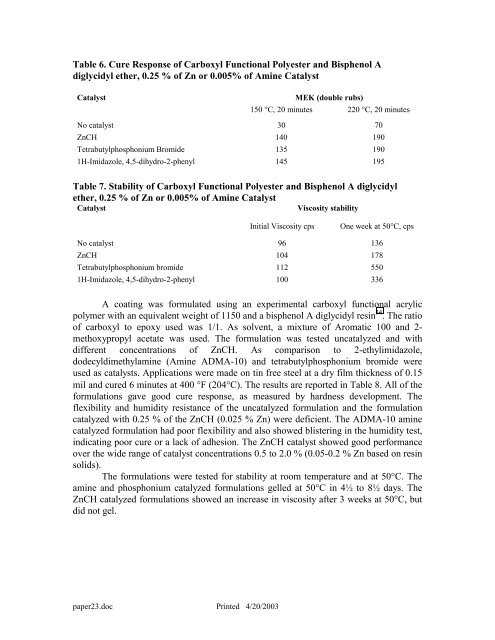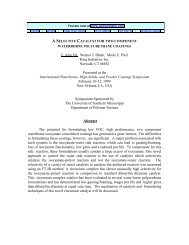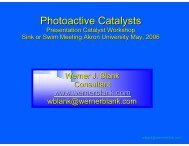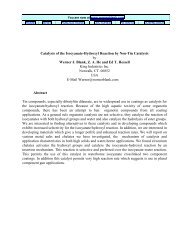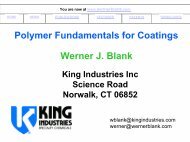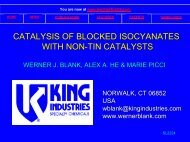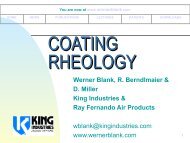Catalysis of the Epoxy-Carboxyl Reaction - Werner Blank
Catalysis of the Epoxy-Carboxyl Reaction - Werner Blank
Catalysis of the Epoxy-Carboxyl Reaction - Werner Blank
Create successful ePaper yourself
Turn your PDF publications into a flip-book with our unique Google optimized e-Paper software.
Table 6. Cure Response <strong>of</strong> <strong>Carboxyl</strong> Functional Polyester and Bisphenol A<br />
diglycidyl e<strong>the</strong>r, 0.25 % <strong>of</strong> Zn or 0.005% <strong>of</strong> Amine Catalyst<br />
Catalyst<br />
paper23.doc Printed 4/20/2003<br />
MEK (double rubs)<br />
150 °C, 20 minutes 220 °C, 20 minutes<br />
No catalyst 30 70<br />
ZnCH 140 190<br />
Tetrabutylphosphonium Bromide 135 190<br />
1H-Imidazole, 4,5-dihydro-2-phenyl 145 195<br />
Table 7. Stability <strong>of</strong> <strong>Carboxyl</strong> Functional Polyester and Bisphenol A diglycidyl<br />
e<strong>the</strong>r, 0.25 % <strong>of</strong> Zn or 0.005% <strong>of</strong> Amine Catalyst<br />
Catalyst<br />
Viscosity stability<br />
Initial Viscosity cps One week at 50°C, cps<br />
No catalyst 96 136<br />
ZnCH 104 178<br />
Tetrabutylphosphonium bromide 112 550<br />
1H-Imidazole, 4,5-dihydro-2-phenyl 100 336<br />
A coating was formulated using an experimental carboxyl functional acrylic<br />
polymer with an equivalent weight <strong>of</strong> 1150 and a bisphenol A diglycidyl resin 34 . The ratio<br />
<strong>of</strong> carboxyl to epoxy used was 1/1. As solvent, a mixture <strong>of</strong> Aromatic 100 and 2methoxypropyl<br />
acetate was used. The formulation was tested uncatalyzed and with<br />
different concentrations <strong>of</strong> ZnCH. As comparison to 2-ethylimidazole,<br />
dodecyldimethylamine (Amine ADMA-10) and tetrabutylphosphonium bromide were<br />
used as catalysts. Applications were made on tin free steel at a dry film thickness <strong>of</strong> 0.15<br />
mil and cured 6 minutes at 400 °F (204°C). The results are reported in Table 8. All <strong>of</strong> <strong>the</strong><br />
formulations gave good cure response, as measured by hardness development. The<br />
flexibility and humidity resistance <strong>of</strong> <strong>the</strong> uncatalyzed formulation and <strong>the</strong> formulation<br />
catalyzed with 0.25 % <strong>of</strong> <strong>the</strong> ZnCH (0.025 % Zn) were deficient. The ADMA-10 amine<br />
catalyzed formulation had poor flexibility and also showed blistering in <strong>the</strong> humidity test,<br />
indicating poor cure or a lack <strong>of</strong> adhesion. The ZnCH catalyst showed good performance<br />
over <strong>the</strong> wide range <strong>of</strong> catalyst concentrations 0.5 to 2.0 % (0.05-0.2 % Zn based on resin<br />
solids).<br />
The formulations were tested for stability at room temperature and at 50°C. The<br />
amine and phosphonium catalyzed formulations gelled at 50°C in 4½ to 8½ days. The<br />
ZnCH catalyzed formulations showed an increase in viscosity after 3 weeks at 50°C, but<br />
did not gel.


